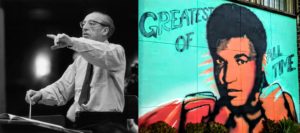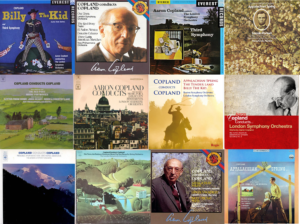
If someone tells you something or gives you a list of things to remember chances are you’ll remember some of the first bits of what they said and some of the last things they say. The middle section of your recall is likely to be a bit fuzzy! This is all about our brain’s ability to retain information in terms of our long term and short term memory. It’s no wonder then that classical composers so often start and end their works with very memorable tunes. Those are the bits that you are most likely to go away humming and make you come back for more or buy the CD or add them to your Spotify account!
Aaron Copland was a master of great beginnings and endings to his works. I’ve been listening to his music for 30 years and I have come up with what I think are the eight categories of Copland endings that he used in his major works. Of course, this is only my view and there are definitely some that cross over from one category to another. I hope you enjoy checking these out.
1) The Long Farewell
This feels as if the end is coming from a long way out. This builds and builds in intensity and is quite overwhelming like holding your breath for a long time and those last few moments you’re simply hanging in there and can’t wait to exhale. The anticipation is massive and sustained.
Copland achieves this type of culmination in two ways – with crashing percussion and brass in the orchestral works and ever slower more drawn out notes in some of his most important piano works. Whereas the orchestral pieces tend to suggest a birth or a new beginning the piano pieces suggest the permanent end which is death. This is certainly the case for the poor mouse in Scherzo Humoristique: The Cat and the Mouse, who is dispatched and goes out with a funeral march. The finale of the “ballet” Grohg is a combination of both as the eponymous living dead vampire disappears into his coffin.
But the Daddy of Long Farewell endings is of course Symphony No 3 especially the uncut version conducted by Leonard Slatkin and the Detroit Symphony Orchestra. Similarly, the Piano Fantasy has the same order of magnitude for the solo piano pieces. Both are shockingly great.
2) The Strong Silent Type
Many Copland endings have a feeling of calm assurance as if the protagonist is standing alone, unbowed and staunchly prepared for the challenges ahead. This is accentuated by the fact that in several of these pieces the orchestration dissolves away to a final single instrument that concludes the work suggesting a strong, resilient heartbeat.
The most notable and sublime ending of this type is of course Appalachian Spring. The perfect finale with the glockenspiel and bell like sound of harp harmonics is for me possibly one of the few places where the orchestral suite version comes out on top of the original ballet score for 13 instruments. In the original, the flute plays the final notes. However, Copland did something not dissimilar almost a decade before with the final movement of Statements. Here, the light brush of a tam tam brings Prophetic to a peaceful if somewhat foreboding conclusion.
3. The Abrupt Halt
The opposite of Copland’s Long Goodbye is his very quick “I’m off” wave. In these Copland endings the denouement comes so quickly that you’re left a bit unawares. Only a few bars before it seems like you’re in the middle of the piece and then in a blink it’s over.
All these pieces are very decisive in their ending. One thing to notice though is the ever so slight difference between the end of the Short Symphony and it transcription for Sextet. In the former there are three full stops and in the latter just one.
With El Salon Mexico and the Clarinet Concerto you can tell the end is coming but in both cases they unerringly seem to retain that element of surprise (well for me at least!).
4. We All Fall Down
Copland specialises in an ending which has an almost silent movie comedy element. In this type of conclusion it always feels like everything comes crashing down in an instant like a table of drinks has been upset or a character has elaborately slipped on a banana skin in the style of Harold Lloyd! Copland used this type of finale at the end of the first (Buckaroo Holiday) and fourth episodes (Hoe Down) of Rodeo. However, you’ll find that he used this type of ending many times during his populist middle period. For the best banana skin ending though, listen to Sunday Traffic from The City and Music for Movies.
The next set of four Copland endings can be found here.








Leave a Comment